The latest episode of On the Record is now available! In this week’s program, we report on Deere & Co.’s second quarter earnings and outlook for the remainder of the year. Publicly traded dealer groups Cervus Equipment and Rocky Mountain Dealerships both reported their first quarter results recently, and put an emphasis on moving used equipment in the quarter. CNH Industrial’s first quarter results took a hit due to unfavorable exchange rates. Also in this episode, Stanley Elliot, analyst with Stifel, provides some analysis of the 2017 USDA Census of Agriculture. In the Technology Corner, Jack Zemlicka talks about planned updates to the Agricultural Electronics Foundation’s compatibility database.
On the Record is brought to you by Walterscheid Powertrain Group.
This episode of On the Record is brought to you by Walterscheid Powertrain Group, a global industry leader for highly engineered, mission critical powertrain systems and complete in-service support for the world’s leading off-highway and industrial equipment manufacturers.
On the Record is now available as a podcast! We encourage you to subscribe in iTunes, the Google Play Store, Soundcloud, Stitcher Radio and TuneIn Radio. Or if you have another app you use for listening to podcasts, let us know and we’ll make an effort to get it listed there as well.
We’re interested in getting your feedback. Please feel free to send along any suggestions or story ideas. You can send comments to kschmidt@lessitermedia.com.
I’m executive editor Kim Schmidt, welcome to On the Record! Here’s an update on what’s currently impacting the ag equipment industry.
Deere’s 2Q19 Ag & Turf Sales Grow 3%
Deere & Co. reported its second quarter results this morning. Net income for the quarter was $1.14 billion, down 6% vs. the same period last year. Total net sales and revenues were up 6% to $11.3 billion, compared to $10.7 billion in the second quarter of 2018.

For the Ag & Turf division, worldwide net sales for the second quarter were up 3% to $7.3 billion. The company says Ag & Turf sales for the quarter and year to date increased due to higher shipment volumes and price realization, partially offset by the unfavorable effects of currency translation.
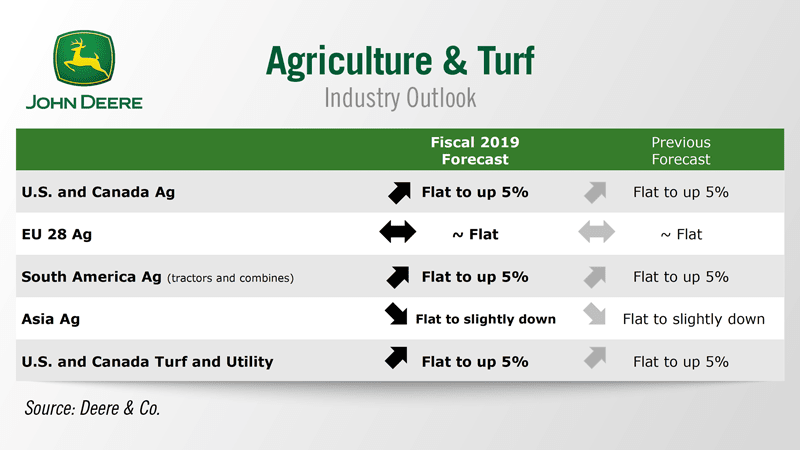
Deere’s forecast for 2019 is unchanged. Industry sales of agricultural equipment in the U.S. and Canada are forecast to be flat to up 5% for the full year, while industry sales in the EU28 member nations are forecast to be about flat. South American industry sales of tractors and combines are projected to be flat to up 5% benefiting from strength in Brazil. Asian sales are forecast to be flat to down slightly. Industry sales of turf and utility equipment in the U.S. and Canada are expected to be flat to up 5% for 2019.
Dealers On The Move
This week’s Dealers on the Move include Blanchard Equipment, Cazenovia Equipment, Premier Equipment, Ohio Machinery Co., Ellens Equipment and Prairieland Partners.
Blanchard Equipment, a John Deere dealer based in South Carolina, announced the relocation of its Clinton, S.C. dealership to Greenwood, S.C. in May.
John Deere dealer Cazenovia Equipment will be consolidating its Watertown and Sandy Creek, N.Y. locations into one 25,000 square foot retail and service center. This will bring Cazenovia’s number of branches down to 8.
Premier Equipment Co., a New Holland dealer based in North Carolina, recently purchased Hines Equipment. They bought the property back in February of this year, along with Enfield Tractor and Equipment.
Ohio Machinery Co. acquired Magnam Truck and Equipment in Lima, Ohio, which will become its sixth location. The property comes with 198 acres of land and three operating facilities, which Ohio Machinery Co. plans to continue operating.
Michigan-based New Holland dealer Ellens Equipment is opened a new store in Ithica, Mich. This is Ellens’ second location.
Prairieland Partners, the largest John Deere dealer in Kansas, has agreed to purchase O’Malley Equipment Co., pending John Deere approval. This will mark their 15th location, and after it’s finalized in June of this year, Prairieland Partners will employ over 400 people.
Now here’s Jack Zemlicka with the latest from the Technology Corner.
AEF to Relaunch Compatibility Database
Equipment compatibility continues to pose challenges for manufacturers, dealers and farmers.
But for the last decade-plus, the Agricultural Electronics Foundation has worked to improve functionality between precision systems, while also increasing awareness of ISOBUS-certified components.
In 2014, the AEF debuted its searchable database of ISO-certified equipment as a resource for manufacturers and their dealers to assess compatibility.
Initially, dealer access to the database came through the manufacturer, which had its limitations, according to Andrew Olliver, marketing and communications lead for AEF.
At this year’s AEF Plugfest event last week in Lincoln, Neb., I caught up with Olliver who shared some of the planned updates to the database which will improve dealer access.
“The improvements to the database are going to focus around improving some of the parts of the conformance assist for ISOBUS products and also enabling access to the database for dealers. Currently, the way the database is set up, is that a dealer has to request access from his manufacturer and the manufacturer grants access. What we've been finding though is that not too many manufacturers have been actively rolling out this possibility to their dealers. So in time for Agritechnica, we're going to be making improvements to the database to actually allow dealers to create their own access by going to the database registering as a dealer. In the end, that access will need to be approved by the manufacturer whose products they represent but we feel this is a good way to actually get more dealers actively using the database.”
Olliver adds that the goal of the database for dealers is to be a tool for knowing in advance which products and systems are ISO-certified, to minimize troubleshooting.
Exchange Rate Hampers CNHI in 1Q19
CNH Industrial reported consolidated revenues of $6.5 billion for the first quarter of 2019, down 5% compared to the first quarter of 2018. However, revenue was up 2% on a constant currency basis. Net sales of Industrial Activities and net sales in agriculture were similarly down 5% and 4% respectively, but on a constant currency basis both were up 2%. Construction’s net sales decreased 6% in the first quarter of 2019 compared to the first quarter of 2018, down 2% on a constant currency basis. Powertrain’s net sales decreased 13% in the first quarter of 2019 vs. the first quarter of 2018, down 6% on a constant currency basis.
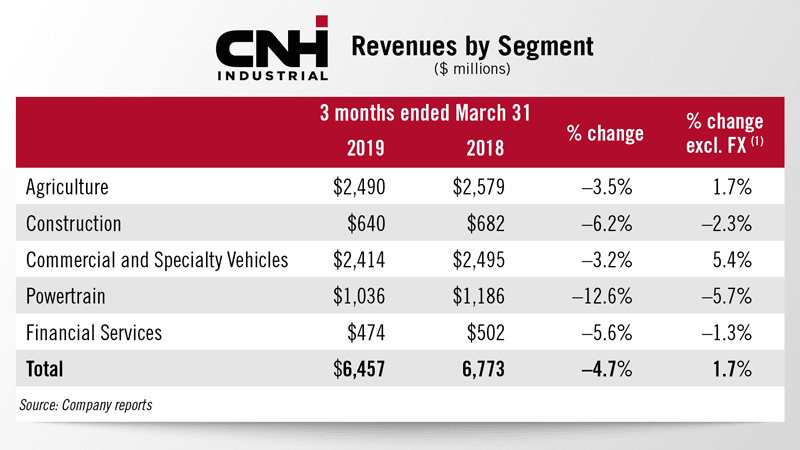
In its outlook for the remainder of 2019, CNHI said that sentiment in the agricultural end-markets remains muted in the short-term, primarily as a result of uncertainties related to unresolved trade tensions, recent negative weather events in Australia and Northern Europe, and geopolitical and macroeconomic uncertainties.
Big Ag Equipment Age Normalizing & Shrinking
Based on 2017 Census of Agriculture and AEM data, analysts at Stifel say the age of the large ag equipment fleet in the U.S. has begun to normalize. In a May 8 note, Stanley Elliott, Stifel analyst, said that 14.5% of U.S. row-crop tractors were built over the last 5 years as of the end of 2017. This down from 16.1% in 2012, but still above the 13.4% average since 1997.
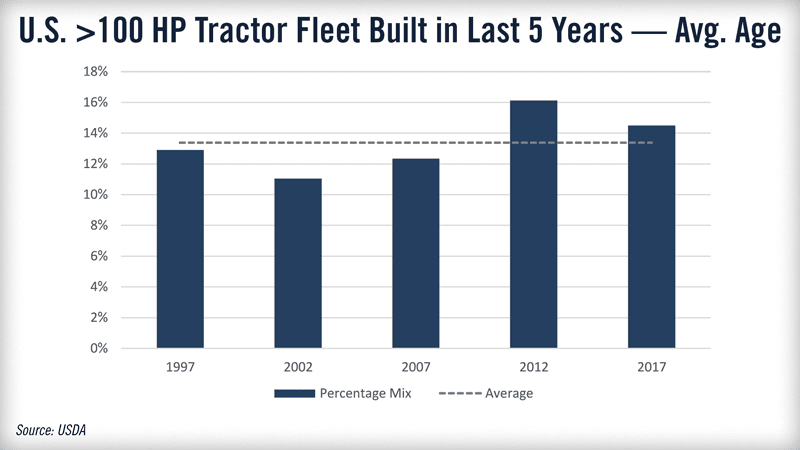
For combines, 14.2% were built over the last 5 years through 2017, down from 16.8% in 2012 and above the 13.3% average since 1982. The Stifel analyst believes fleet ages likely further normalized in 2018 as sales were below replacement demand.
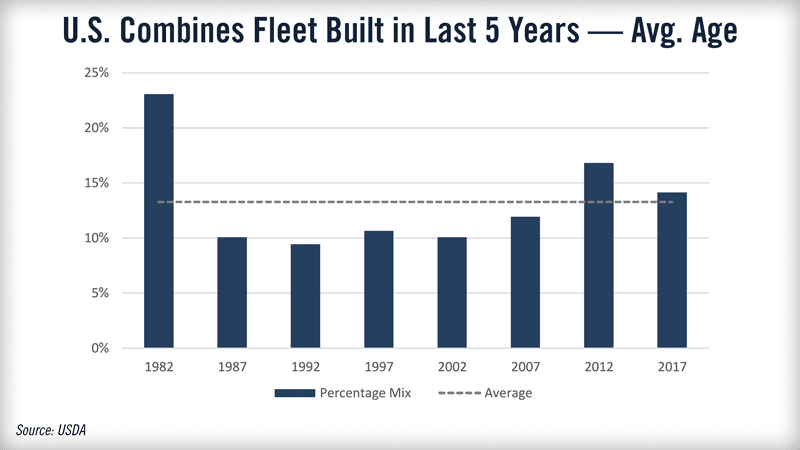
Elliott also said that total size of the U.S. fleet is shrinking as equipment gets larger.
The total number of tractors in operation has declined from about 4.4 million in 1997 to 4 million in 2017. Breaking down the numbers further, he points out the number of over 100 horsepower tractors has grown from about 915,000 in 1997 to roughly 1.2 million in 2017, or nearly 31% of total.
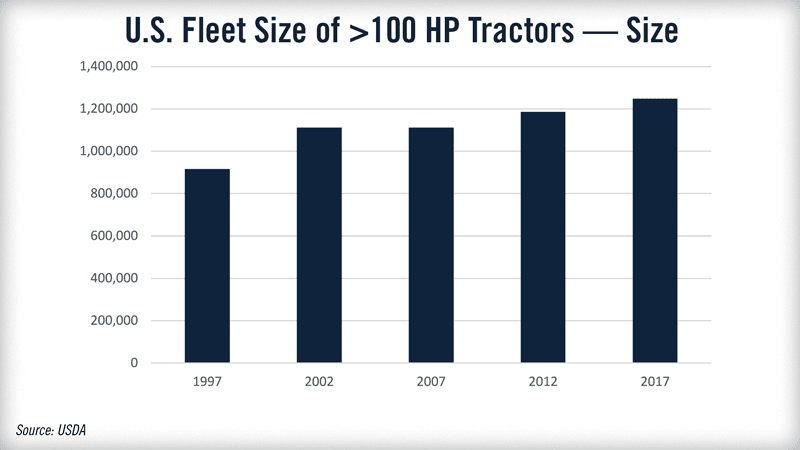
For combines, the number of units in operation peaked in 1987 at approximately 667,000 and has fallen to roughly 323,000 units in 2017. Elliott said they “believe this is also due to larger, more efficient combines being sold relative to prior decades, but underlying data does not break out combines by size.”
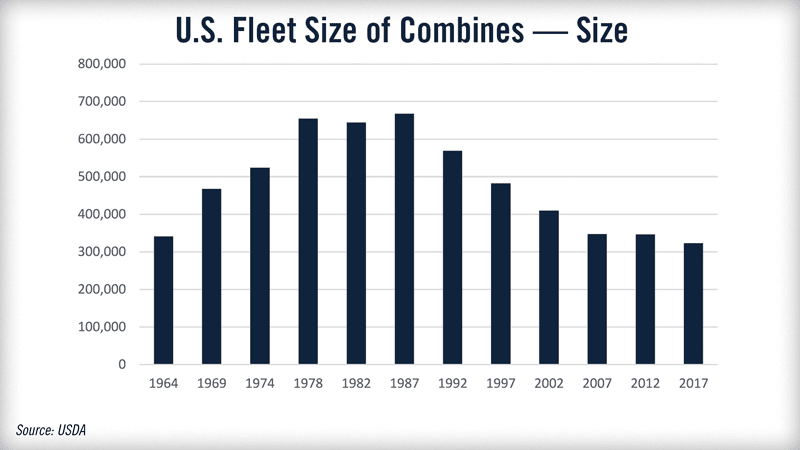
“But then the second piece would be the migration that we've seen into larger more production class farms. In terms of the age of the fleet. The USDA data because it's once every 5 years it's going to end up skewing the numbers a little bit higher than it would be. Alright, yes, right just because you're pulling in from some of the heavier years, but depending on your assumption for you are looking at the fleet age is that we continue to see and undergo more of a normalization, you know, admittedly that those numbers are kind of skewing things may be a little bit higher just because of the time
,the 2012-13 and 2014 period … but fleet age is a little bit ahead of where we've been in the past.”
Canadian Dealers Focus on Used Equipment Sales
Rocky Mountain Dealerships, Case IH’s largest agriculture equipment dealer in Canada, reported that its first quarter sales in 2019 dropped 19% or by nearly $42 million, to $178 million vs. $220 million for the same period in 2018. Gross profit decreased by 5% or $1.4 million to $25.6 million from nearly $27 million for the first quarter of last year. RME said the fall off was due primarily to a $47 million decline “in same store new equipment sales … as we limit presale activity and focus on distributing existing inventory.” Garrett Ganden, president and CEO, said, while they had faced challenges this quarter, their sales and operations teams delivered solid revenue growth in both parts and service.
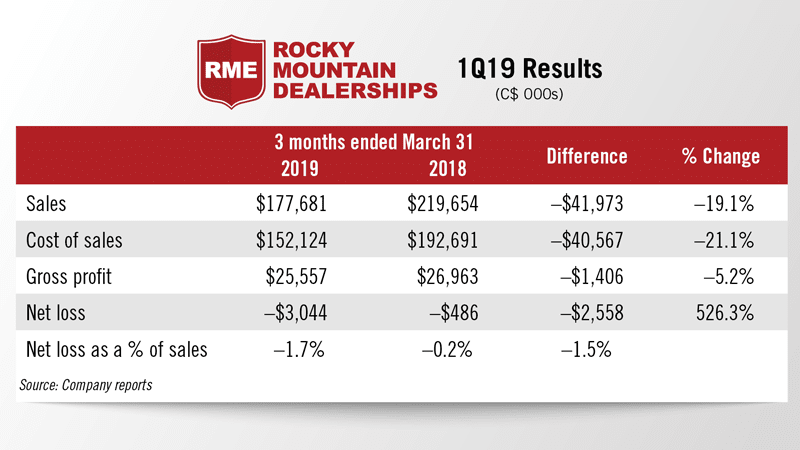
Ben Cherniavsky, analyst at Raymond James, cites RME’s growth in parts and service revenues and the future prospects of the dealership’s new stateside operations in Kansas, saying that, “… this location could lead to some compelling opportunities for both organic growth and/or bolt-on acquisitions.”
Cervus Equipment, John Deere’s largest Canadian dealership group, announced a 6% drop in consolidated revenues for the first quarter of 2019. Revenues from its equipment sales during the first quarter were down nearly 10% compared to the same period in 2018, when revenue declined to C$235 million from $249 million.
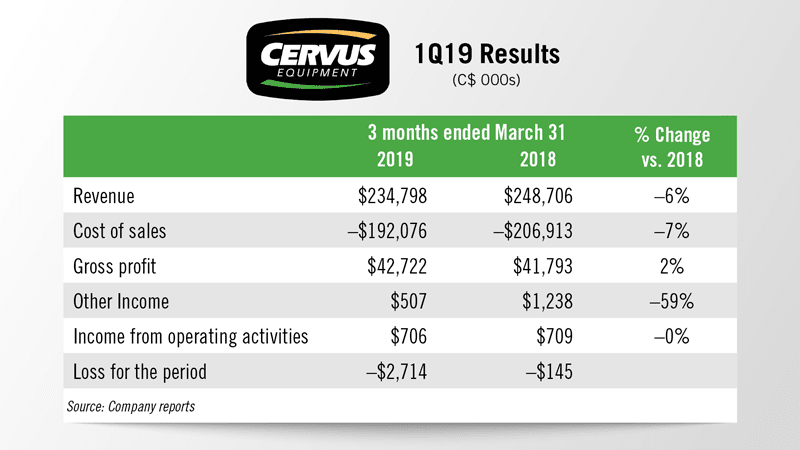
The increased Canadian dollar cost of new equipment was a significant factor in the 19% reduction from record high sales in the first quarter of 2018, according to Cervus. However, the dealership also said that the difficult 2018 Canadian harvest had boosted their parts and services revenue by 18%, compared to the first quarter of 2018, and that they have been successful in increasing sales of used equipment, with sales revenue increasing 21% from the first quarter of 2018.
Overall, the company reported a loss of $2.7 million in its ag division during the first quarter of 2019 vs. a loss of $0.1 million during the first quarter of 2018. Initial adoption of IFRS 16 increased the net loss by $1.5 million in the first quarter of 2019, according to Cervus.
And now from the Implement & Tractor Archives…
Implement & Tractor Archives
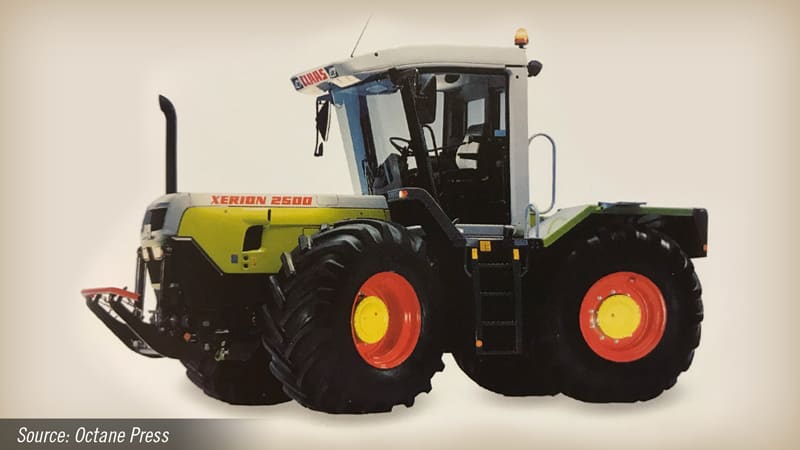
In 1997, Claas introduced its Xerion four-wheel steer CVT tractor. It was originally designed to take on both traditional tractor roles and to accommodate wraparound grain, beet and forage harvesting units. Issues with output, cost and body-swapping speed refocused subsequent development on providing an alternative to articulated steer high horsepower tractors. A hydraulically reversible cab option allowed operation facing rearward to work with implements such as triple mowers.
As always we welcome your feedback. You can send comments and story suggestions to kschmidt@lessitermedia.com. Until next time, thanks for joining us.

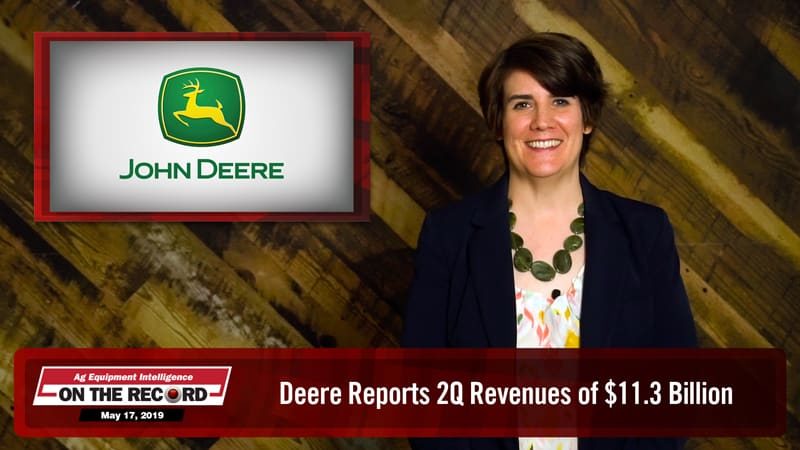




![[Technology Corner] Quantifying the Impact of a Precision Ag Pioneer](https://www.agequipmentintelligence.com/ext/resources/2024/08/23/Quantifying-the-Impact-of-a-Precision-Ag-Pioneer.png?height=290&t=1724422794&width=400)
Post a comment
Report Abusive Comment